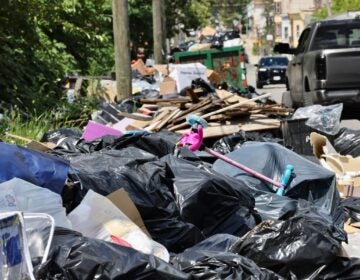St. James School, 11 weeks into inaugural school year
The 16 fifth-graders of the St. James School’s inaugural academic year get a very early start: breakfast begins at 7:15 a.m. in a room of the former church building, which features wooden beams, large windows, and tasteful hanging fixtures that the kids call “fancy lights”.
“It’s not a lunchroom,” the young Ajia Hendricks announced with pride on a recent student-led tour for school supporters, pointing out a gracious piano in the corner. “It’s a dining room.”
With a school-day that routinely lasts from 7:15 a.m. to dinner time 11 months of the year, it’s no wonder that the dining room – which serves up a government-subsidized breakfast and afternoon snack in addition to freshly prepared lunches from St. James partner Penn Charter – would be a focal point for the students.
Those unfamiliar with the St. James program might marvel at such extensive classroom time for middle-schoolers, but the interdisciplinary academics are fluidly balanced with abundant art, music, sports and field trips: “we get to do fun stuff,” said Ajia.
“Longer days give you more time to learn,” added 5th-grade Student Ambassador Lashay Smith, explaining why she likes her school day.
Combating social barriers
The challenges most St. James students face in their quest to learn were the focus of a recent presentation at the school by Dr. Jeanne Felter, an adjunct professor in Applied Psychology at the University of Pennsylvania and a practicing mental health clinician working within the Philadelphia School District. She’s also the site supervisor to University of PA interns at St. James, and works weekly with St. James students and families.
“We want to combat the barriers kids have to learning,” she said of her work with at-risk kids like the students of St. James, noting that their Allegheny West neighborhood has a poverty rate two times the national average, and far exceeds average property and violent crime rates. In fact, statistics say that up to 60-percent of the kids in her care witness or experience some kind of violence, though she puts her own estimate closer to 80-percent, because many incidents – especially domestic violence – often go unreported. Fatal gun violence, as well as absent or incarcerated parents, also impact a significant number of current St. James students. When such trauma is a routine reality for children, a positive school day can offer more than an educational opportunity – it can offer a crucial “respite from the chaos.”
Dr. Felter explained the mental and even physiological effects of kids’ exposure to persistent and prolonged violence. This has been associated with physical changes in the brain, which can affect behavioral inhibitions, focus and memory – all of which make academics even more of a challenge for affected children.
But especially given the problems that many St. James students face, just 11 weeks into the school’s very first year, the effects of the classrooms’ atmosphere are obvious.
A ‘whole child’ approach
During a language arts lesson led by Principal and English-teacher Laura Hoffman-Dimery, the 16 desks (half the average class-size in Philadelphia) were grouped in small clusters to promote in-class cooperation and socialization. Student pairs faced off in a debate exercise, and then a trio of girls sang a song they wrote themselves about adverbs, verbs, and adjectives. This multi-faceted approach to learning infuses every part of the St. James curriculum, from collaborative art projects to an outdoor garden, where kids learn about good nutrition while they grow their own herbs, squash, eggplant, greens and berries.
Through a “word of week” program, kids tackle high-school level vocabulary together, and are learning algebra and exponents in math. Students greeted visitors with confident courtesy, and offered poised and articulate tours to adult guests.
Founded through a nationwide program known as the NativityMiguel Network of Schools, St. James is not a public or a charter school, and Executive Director David Kasievich appreciates the freedom this brings for a well-rounded academic, spiritual, social and physical curriculum.
“We’re able to have a whole child approach,” he said, connecting with families in person and working to meet the needs of the students, not standardized mandates.
Invested in student success
Though the yearly cost for each child is $22,000, very little of the school’s budget comes from tuition fees. Parents pay only $250 per year (about $21 per month), so St. James relies heavily on charitable contributions. In her search for “creative funding sources”, Development Associate Maria Newman looks forward to joining Pennsylvania’s unique Educational Improvement Tax Credit Program, in which local merchants can send a portion of their taxes directly to nearby educational institutions. The school, which will eventually host 5th through 8th grade students, is always on the lookout for donors and volunteers to make its continued mission possible.
Perhaps best of all, St. James, situated on four acres of land, doesn’t skimp on recess. Ajia pointed out the “Grandma Tree”, site of the girls’ favorite game, in which a chosen “Grandma” chases the kids from her tree. Choosing Grandma is almost as fun as the game itself: the girls line themselves up and present their best Grandma voices in a daily group audition, and the players vote on their favorite.
St. James is a far cry from Lashay’s old school, where her class topped forty kids and “we never had any debates or grammar songs.” As for the future, Lashay and Ajia both want to be pediatricians – or maybe singers or dancers. School staffers hope that whatever they choose, St. James will play a major role in helping them achieve their goals.
WHYY is your source for fact-based, in-depth journalism and information. As a nonprofit organization, we rely on financial support from readers like you. Please give today.







